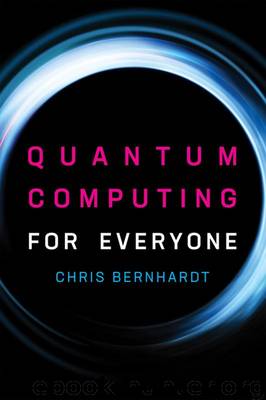Quantum Computing for Everyone by Bernhardt Chris;

Author:Bernhardt, Chris; [Bernhardt, Chris;]
Language: eng
Format: azw3
Tags: quantum cryptography, matrix, circuits, computational chemistry, polarization, spooky action, vector, algorithms, quantum computing, qubit, spin, superposition
Publisher: MIT Press
Published: 2019-02-22T00:00:00+00:00
6
Classical Logic, Gates, and Circuits
In this chapter we briefly study classical computation, presenting the ideas in roughly chronological order. We start with boolean functions and logic, first introduced by George Boole in the late nineteenth century. In the 1930s, Claude Shannon studied boolean algebra and realized that boolean functions could be described using electrical switches. The electrical components that correspond to boolean functions are called logic gates. Composing boolean functions becomes the study of circuits involving these gates. We will begin by studying boolean functions in terms of logic; then we will show how to translate everything into circuits and gates. The material, up to this point, is now considered standard and is contained in every introductory computer science text. But after this we look at some ideas that are usually not part of the standard introduction.
In the 1970s, the Nobel Prize–winning physicist Richard Feynman became interested in computing and, for a few years in the early 1980s, he gave a course on computation at the California Institute of Technology. These lectures were eventually written up as Feynman Lectures on Computation. Feynman’s interest in computation was partly due to his interaction with Edward Fredkin and Fredkin’s idiosyncratic views of physics and computation. Fredkin believes that the universe is a computer, and that since the laws of physics are reversible we ought to study reversible computation and reversible gates. But even though Fredkin’s overarching thesis is not widely accepted in the physics community, he is recognized for having some brilliant and unconventional ideas. One of these is the billiard ball computer. Feynman’s book includes a discussion of reversible gates and shows how any computation can be performed by bouncing balls off one another.
We take Feynman’s approach. It turns out that reversible gates are exactly what we need for quantum computing. The billiard ball computer led Feynman to think of particles interacting instead of balls. It was the inspiration for his work on quantum computing, but we include it here mainly because of its sheer simplicity and ingenuity.
Download
This site does not store any files on its server. We only index and link to content provided by other sites. Please contact the content providers to delete copyright contents if any and email us, we'll remove relevant links or contents immediately.
| Computer Vision & Pattern Recognition | Expert Systems |
| Intelligence & Semantics | Machine Theory |
| Natural Language Processing | Neural Networks |
Algorithms of the Intelligent Web by Haralambos Marmanis;Dmitry Babenko(16237)
Jquery UI in Action : Master the concepts Of Jquery UI: A Step By Step Approach by ANMOL GOYAL(9389)
Test-Driven Development with Java by Alan Mellor(7737)
Data Augmentation with Python by Duc Haba(7610)
Principles of Data Fabric by Sonia Mezzetta(7380)
Learn Blender Simulations the Right Way by Stephen Pearson(7296)
Microservices with Spring Boot 3 and Spring Cloud by Magnus Larsson(7139)
Hadoop in Practice by Alex Holmes(6589)
RPA Solution Architect's Handbook by Sachin Sahgal(6519)
The Infinite Retina by Robert Scoble Irena Cronin(6217)
Big Data Analysis with Python by Ivan Marin(5937)
Life 3.0: Being Human in the Age of Artificial Intelligence by Tegmark Max(5518)
Pretrain Vision and Large Language Models in Python by Emily Webber(4896)
Infrastructure as Code for Beginners by Russ McKendrick(4654)
Functional Programming in JavaScript by Mantyla Dan(4438)
WordPress Plugin Development Cookbook by Yannick Lefebvre(4385)
The Age of Surveillance Capitalism by Shoshana Zuboff(4250)
Embracing Microservices Design by Ovais Mehboob Ahmed Khan Nabil Siddiqui and Timothy Oleson(4149)
Applied Machine Learning for Healthcare and Life Sciences Using AWS by Ujjwal Ratan(4136)
